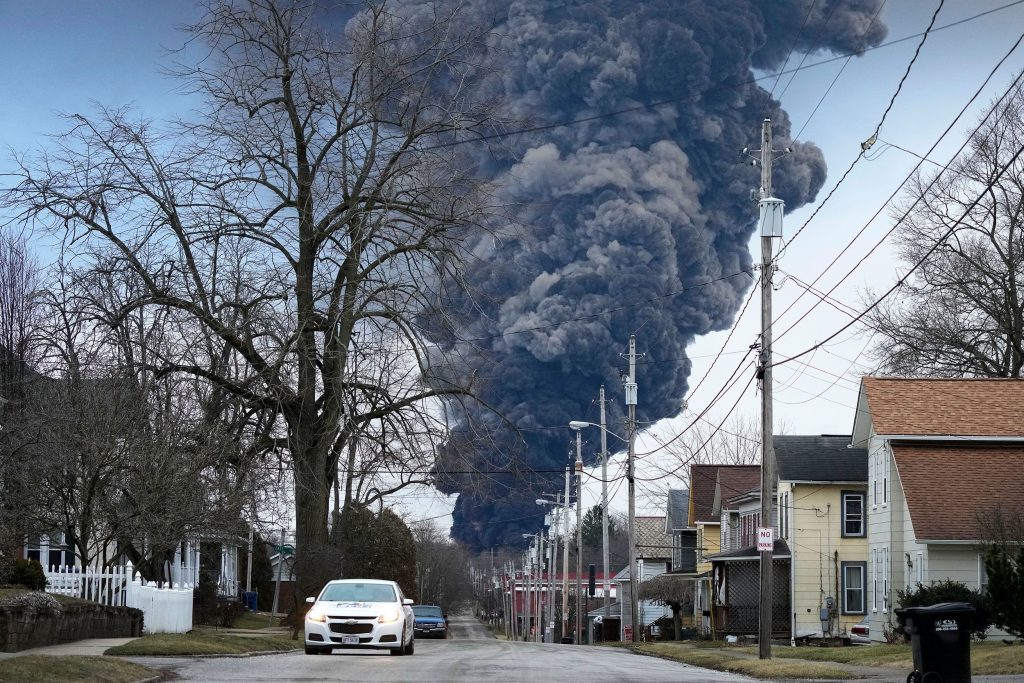Environment Canada monitoring possible ‘impact’ of toxic fumes in Ontario after Ohio train derailment

Posted February 21, 2023 3:50 pm.
Last Updated February 22, 2023 8:20 am.
Environment Climate Change Canada (ECCC) is actively monitoring the potential environmental impacts in Ontario caused by the significant train derailment in Ohio earlier this month that sparked a massive fire and sent fumes from several toxic chemicals into the air.
About 50 cars were derailed in East Palestine on Feb. 3 as a train carried various products from Madison, Illinois, to Conway, Pennsylvania.
Norfolk Southern, a transportation company, said 20 of the more than 100 cars were classified as carrying hazardous materials — defined as cargo that could pose any danger “including flammables, combustibles, or environmental risks.” The derailment prompted an evacuation as fears grew about a potential explosion of smouldering wreckage.
No injuries or damage to structures were reported, but it’s been confirmed that 14 cars carrying vinyl chloride were involved in the derailment and were exposed to fire. Vinyl chloride — a clear, flammable gas used to produce polyvinyl chloride plastic — can cause liver cancer in high doses. Lower doses, specifically over long periods, could pose health risks to humans.
“ECCC is aware of the Feb. 3, 2023, train derailment in the town of East Palestine, Ohio, U.S.A., which caused a major explosion and release of toxic and carcinogenic chemicals,” a spokesperson for Environment Canada said.
Ontario is five to seven-and-half hours from Ohio by car and borders the province across Lake Erie. Though it’s unclear how the explosion could impact Ontarians, Canada’s weather agency said that vinyl chloride typically only lasts in the atmosphere for less than 24 hours.
“ECCC takes pollution incidents and threats to the environment very seriously. ECCC is monitoring the impact of the Ohio train derailment. ECCC’s National Environmental Emergencies Centre is in contact with our counterparts at the U.S. Environmental Protection Agency and the Ontario Ministry of the Environment, Conservation and Parks.”
American residents concerned about health risks, safety of pets
U.S. residents from nearby neighbourhoods in Ohio and Pennsylvania were evacuated because of health risks from the fumes. They later were allowed to return, but many say they’ve experienced headaches and eye irritations and worry about long-term effects.
Others have complained about finding their cars covered in soot, their homes filled with overpowering odours, and their pets getting sick or dying. The chemicals also spilled into nearby creeks, killing thousands of fish, and a smaller amount eventually made their way into the Ohio River.
“ECCC will continue to monitor the situation and are ready to provide scientific support and expert environmental advice as needed,” Environment Canada added.
“ECCC is available 24/7 to provide science-based expert advice to protect the environment from emergency pollution incidents that impact Canada.”
There were more than 12,400 train derailments in the U.S. over the past decade, or more than 1,200 annually, according to Federal Railroad Administration data based on reports submitted by railroads.
Those accidents combined derailed or damaged about 6,600 tank cars carrying hazardous materials — including 348 cars that released their contents — and prompted evacuations involving more than 18,600 people.
With files from The Associated Press










